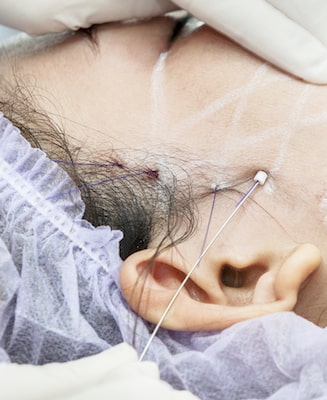
As the face ages, the skin can start to sag and give a person an older look. The sagging skin can make someone look like they have cheeks that are drooping or there is the formation of jowls. One of the most popular methods for rejuvenating the facial appearance of a person is a thread lift that tightens the skin on the face. The surgeon uses thread to pull sagging portions of the skin upwards in order to lessen the signs of aging and provide a more youthful appearance. Let’s begin this look at the thread lift process with an exclusive Cosmetic Town TV “Q&A” about the topic with a double-board-certified Los Angeles facial plastic surgeon:
As mentioned above, the purpose of a thread lift is to tighten sagging skin on the face. It is an option that is often picked by patients who do not want to under an invasive facelift (since a thread lift is considered to be minimally invasive).
During the procedure, the surgeon uses a thread, AKA a temporary suture, to lift the sagging portions of the skin. The doctor places a thin cannula or needle into the skin in order to insert threads under the skin so it can be lifted. The threads and barbs that are inserted are able to pull the skin upwards and give the face a look that is tighter and lifted. In addition, a thread lift can promote the production of collagen in the treated area to also give the skin a more youthful and refreshed look.
The areas of the face that can be lifted with a thread lift include the jowls, skin on the neck, loose facial structures, and eyebrows that are sagging.
A person who is a good candidate for a thread lift is often between the ages of thirty and sixty and has an overall good skin tone. These candidates are starting to experience some amount of sagging on the face and neck but not enough drooping skin that requires an invasive facelift to address the loose skin.
In general, a thread lift is often a good choice for a person who wants a more youthful look to the face thanks to the reduction of sagging skin, wrinkles, or jowls.
 A thread lift requires much less recovery time than a surgical facelift because it is not as invasive. The patient only receives a local anesthetic, so it does not take as much time to recover from the effects of the anesthetic.
A thread lift requires much less recovery time than a surgical facelift because it is not as invasive. The patient only receives a local anesthetic, so it does not take as much time to recover from the effects of the anesthetic.
There will be some soreness, swelling and redness after the treatment but most people are able to go back to work immediately after the procedure (as opposed to the one or two weeks off work a person will need to take after a surgical facelift).
A thread lift has a very low chance of creating any scars in the treated area.
Since a thread lift is considered to be a noninvasive treatment, there is less of a risk of complications after the procedure. There are some side effects patients should know about related to the local anesthesia and they include a sore throat, nausea, and muscle aches.
One of the drawbacks to a thread lift is not everyone is an ideal candidate for the procedure, A thread lift is only able to lift the face by a few millimeters. Even though this means the results are subtle in nature and have a natural look, a person with skin that is quite loose will likely not enjoy a good amount of results.
The results of a thread lift are not permanent, and they generally only last for one or two years. A follow-up treatment will be necessary to maintain the results.
There are some side effects that can occur after a thread lift and they include snapping of the threads, infection or inflammation of the sutures and bleeding at the area of the body where the thread lift was performed (this blood can accumulate under the skin).
The first step in the thread lift process is scheduling a consultation appointment with a surgeon who is both board-certified and experienced in performing a thread lift. The doctor will determine the current condition of loose skin on the face so a decision can be made if the person is an ideal candidate for a thread lift or if a facelift will be necessary to address the amount of loose skin.
The doctor will also need to take the time to explain the benefits and drawbacks of having a thread lift so the patient will have the necessary information to make an informed decision about the treatment. Once the patient has all of the information about their specific case, they can make a decision about having a thread lift to turn back the clock on the appearance of the face.
- MA